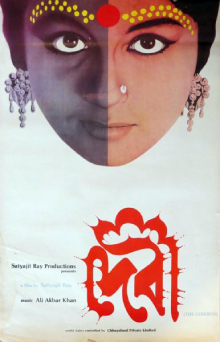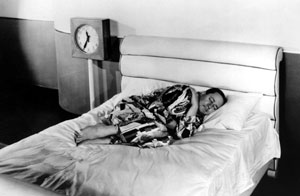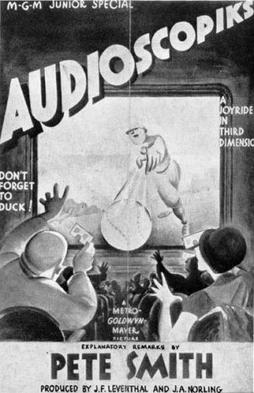Related Research Articles

David Andrew Leo Fincher is an American film director. His films, most of which are psychological thrillers, have collectively grossed over $2.1 billion worldwide and have received numerous accolades, including three nominations for the Academy Awards for Best Director. He has also received four Primetime Emmy Awards, two Grammy Awards, a BAFTA Award, and a Golden Globe Award.

George Campbell Scott was an American actor, director and producer. He had a celebrated career on both stage and screen. With a gruff demeanor and commanding presence, Scott became known for his portrayal of stern but complex authority figures.

Devi (transl. Goddess) is a 1960 Bengali-language drama by director Satyajit Ray, starring debutante Sharmila Tagore and Soumitra Chatterjee. It is based on a short story by Prabhat Kumar Mukhopadhyay. The film is based on believing on a dream, that a Zamindar has witnessed, where he is delusional about his daughter-in-law revealing herself into a Goddess incarnate, worthy of being idolized and worshiped.
Dante Spinotti, ASC, AIC is an Italian cinematographer. He is known for his collaborations with directors such as Michael Mann, Michael Apted, Ermanno Olmi, Bruce Beresford, Curtis Hanson, and Brett Ratner. He received Academy Award nominations for L.A. Confidential (1997) and The Insider (1999), and won a BAFTA Award for The Last of the Mohicans (1992). He has also won two Italian David di Donatello Awards and two Nastro d'Argento Awards.
The 8th Academy Awards to honour films released during 1935 were held on March 5, 1936, at the Biltmore Hotel in Los Angeles, California and hosted by AMPAS president Frank Capra. This was the first year in which the awards were called "Oscars".

How to Sleep is a short comedy film written by and starring humorist Robert Benchley. Filmed and released by MGM in 1935, it features Benchley as a narrator as well as film subject, discussing four parts of sleep—causes, methods, avoiding sleep, and waking up.
William Slavens McNutt, was an American screenwriter. He wrote for 28 films between 1922 and 1939. He was nominated for an Academy Award on two occasions. At the 5th Academy Awards, he was nominated for the Academy Award for Best Story for Lady and Gent. In 1936, he was nominated for Adapted Screenplay for the film The Lives of a Bengal Lancer. He was born in Urbana, Illinois and died in San Fernando, California.
Battle for Life is a nature documentary series made from 1932 until 1934 by Horace Woodard and Stacy Woodard, The short films include the 1935 Oscar award-winning City of Wax, about honey bees. The one-reel short films were released by Educational Pictures. A homemade camera setup for closeups was used. The Woodards followed the series with another series titled Struggle to Live.
Wings over Everest is a 1934 British short documentary film directed by Geoffrey Barkas and Ivor Montagu. It won an Academy Award in 1936 for Best Short Subject (Novelty). It described the 1933 Houston-Mount Everest flight expedition, in which Douglas Douglas-Hamilton, 14th Duke of Hamilton, otherwise known as Lord Clydesdale, piloted a single-engined biplane on 3 April 1933, just clearing Everest's southern peak by a few feet, having been caught in a powerful downdraught. The film used mixture of real footage of Everest from the record-breaking flight and theatrically produced scenes using the actual people rather than actors.
Busy Little Bears is a 1939 American short family film directed by John A. Haeseler. It won an Oscar at the 12th Academy Awards in 1940 for Best Short Subject (One-Reel). The film was preserved by the Academy Film Archive, in conjunction with the UCLA Film and Television Archive, in 2013.

A Chance to Live is a 1949 American short documentary film directed by James L. Shute, produced by Richard de Rochemont for Time Inc. and distributed by Twentieth Century-Fox. It is part of The March of Time series and portrays Monsignor John Patrick Carroll-Abbing building and running a Boys' Home in Italy.
Oh, My Nerves is a 1935 American short comedy film directed by Del Lord. It was nominated for an Academy Award at the 8th Academy Awards, held in March 1936, for Best Short Subject (Comedy). The Academy Film Archive preserved Oh, My Nerves in 2012.

Audioscopiks is a 1935 American short documentary film directed by Jacob F. Leventhal and John A. Norling. The main point of the short was to show off 3-D film technology. The film was nominated for an Academy Award at the 8th Academy Awards in 1935 for Best Short Subject (Novelty).
Double or Nothing is a 1936 American short musical comedy film directed by Joseph Henabery. It was nominated for an Academy Award at the 9th Academy Awards in 1936 for Best Short Subject (Two-Reel). The Academy Film Archive preserved Double or Nothing in 2013.
Dummy Ache is a 1936 American short comedy film directed by Leslie Goodwins. It was nominated for an Academy Award at the 9th Academy Awards in 1936 for Best Short Subject (Two-Reel). The Academy Film Archive preserved Dummy Ache in 2013.
Leslie Goodwins was an English film director and screenwriter. He directed nearly 100 films between 1926 and 1967, notably 27 features and shorts with Leon Errol, including the Mexican Spitfire series. His 1936 film Dummy Ache was nominated for an Academy Award in 1936 for Best Short Subject (Two-Reel). Dummy Ache was preserved by the Academy Film Archive and the Library of Congress in 2013. His 1937 film Should Wives Work? was also nominated for an Academy Award in the same category. He was born in London, England and he died in Hollywood, California.

The Titan: Story of Michelangelo is a 1950 German documentary film about the painter and sculptor Michelangelo. It won the Academy Award for Best Documentary Feature.
The Seeing Eye is a 1951 American short documentary film produced by Gordon Hollingshead in Technicolor as a Technicolor Special about The Seeing Eye, a guide dog training school in Morristown, New Jersey. It was nominated for an Academy Award for Best Documentary Short. The Seeing Eye was preserved by the Academy Film Archive in 2006.
References
- ↑ "The 8th Academy Awards (1936) Nominees and Winners". oscars.org. Archived from the original on July 6, 2011. Retrieved August 7, 2011.
- ↑ "Preserved Projects". Academy Film Archive. Archived from the original on August 13, 2016. Retrieved August 3, 2016.